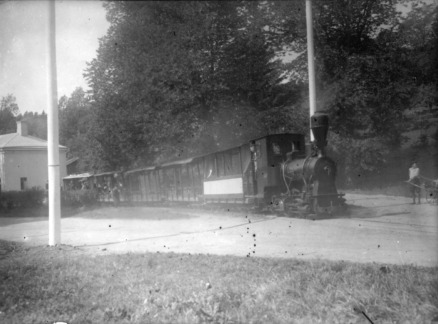Here you can read about the history of the steam locomotive Pikku-Pässi, and the Fiskars’ narrow-gauge railtrack.
During the 19th century, the world changed rapidly – and in Finland, industry began to take its place in everyday life. At the Fiskars Ironworks, ideas emerged that would play an important role in the country’s technological development. Finland’s first steam engine was built here, and the first motorized narrow-gauge locomotive, Pikku-Pässi, also ran here.
This page brings together stories from a time when steam power, innovation, and determination drove progress forward. Through historical snapshots, you’ll discover how people, machines, and environments shaped a unique part of Fiskars’ and Finland’s industrial heritage.
Welcome to explore more – each story is a piece of a larger whole.
Industrialization, Steam Power, and Fiskars Ironworks
The 19th century brought sweeping industrial changes across the world. Finland, once heavily reliant on agriculture, gradually transformed into an industrial society.
Read more about Industrialization, Steam Power, and Fiskars IronworksImporting Pikku-Pässi from Germany
Pikku-Pässi was imported to Fiskars from Germany via Krauss factory’s agent in Finland, Axel von Knorring’s Technical Bureau. The order was mentioned in the newspaper Teknikern on March 1,
Read more about Importing Pikku-Pässi from GermanyTechnical Specifications of Pikku-Pässi
Pikku-Pässi’s manufacturing number is 2517/1891, although it was built as early as 1890. Its track gauge is 750 mm, and it weighs less than 6 tons.
Read more about Technical Specifications of Pikku-PässiAlbert von Julin – The industrial leader who put Fiskars on track
Albert von Julin, born on December 22, 1846, in Pohja, was a distinguished businessman and industrial leader. His father, John von Julin,
Read more about Albert von Julin – The industrial leader who put Fiskars on trackPikku-Pässi’s personnel
On Fiskars’ narrow-gauge railway, people worked with both knowledge and skill to keep the train running.
Read more about Pikku-Pässi’s personnelPikku-Pässi’s Passengers
Although Pikku-Pässi was primarily used for transporting goods through Fiskars, it also became an integral part of people’s lives beyond work. On occasion,
Read more about Pikku-Pässi’s PassengersThe Fiskars Track
Before the establishment of the Fiskars track, where travelers could ride either the Pikku-Pässi or a hand-powered rail cart known as a draisine or trolley,
Read more about The Fiskars TrackOne Locomotive, Two Ironworks, Countless Memories
With the rise of automobile transport, the Fiskars railway was shut down in 1952, deemed unprofitable and outdated. Freight trains were replaced with trucks,
Read more about One Locomotive, Two Ironworks, Countless MemoriesSources and further reading
This page offers a curated list of sources and further reading for anyone interested in steam locomotives, the evolution of railways, and the charm of narrow-gauge trains.
Read more about Sources and further reading